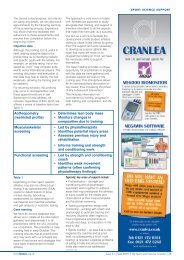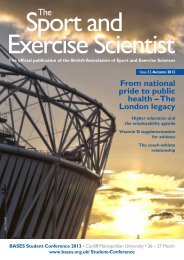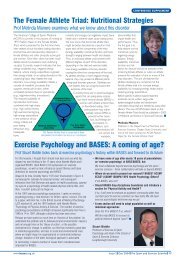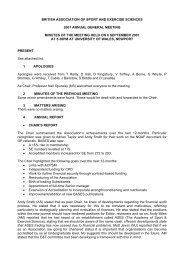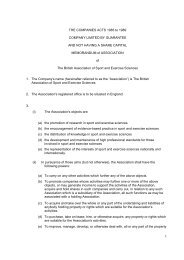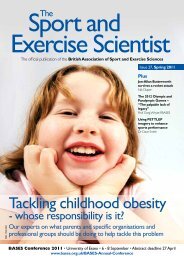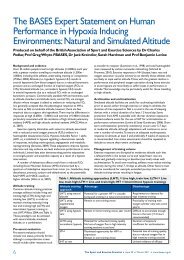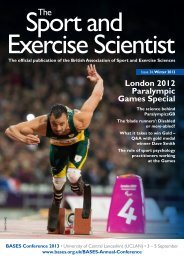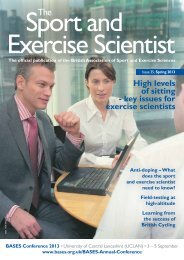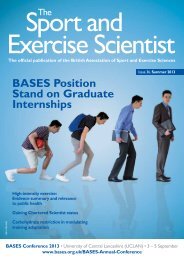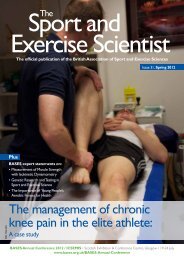Part 1 - Bases
Part 1 - Bases
Part 1 - Bases
- No tags were found...
Create successful ePaper yourself
Turn your PDF publications into a flip-book with our unique Google optimized e-Paper software.
ISSN 1754-3452The official publication of the BRITISH ASSOCIATION OF SPORT AND EXERCISE SCIENCESISSUE 16 JUNE 2008WHY “PARTICIPANTS” RATHER THAN “SUBJECTS”?Prof Edward Winter provides a persuasive account10-PAGE STRICTLY FOR STUDENTS SPECIALCareers advice and Student Conference review2008 BASES ANNUAL CONFERENCELooking forward to September at Brunel Universitywww.bases.org.ukPromoting Issue Excellence 15 l March 2008 in Sport l The Sport and and Exercise Scientist Sciences l 1
2008 BASESAnnual ConferenceTuesday 2 – Thursday 4 SeptemberBrunel University, West London, UB8 3PH, UKDay 1The Performing Athlete• Keynote: Where from here? Reflections on Beijing:Prof Dave Collins, Performance Director,UK Athletics• Symposia highlights and confirmed speakers:• New Frontiers in Physiology: Profs BengtSaltin, Jerome Dempsey, Paul Greenhaff &José González-Alonso• The Role of Implicit Cognitions in Sport: DrsRich Masters, John van der Kamp & RobinJackson• Biomechanics of Performance: Prof AlanWilson, Dr Anthony Blazevich & DavidColemanDay 2Health and Physical Activity• Keynote: 21st Century Health• Symposia highlights and confirmed speakers:• Lifestyle vs. Chronic Disease: Prof ChrisRiddoch, Dr Guy Faulkner & Dr Amelia Lake• Exercise and Chronic Heart Failure: ProfsPatrick Doherty & Keith George; Drs PaulBromley, Lee Ingle & Rob Shave; and CathBindoff, Ros Leslie & Fiona Lough• British Psychological Society• FES Rowing: Prof Brian Andrews, Dr DanBishop & Robin GibbonsDay 3Youth and the Legacy of the Games• Keynote: International Inspiration Programme:Debbie Lye, Head of Worldwide Impact, UK Sport• Symposia highlights and confirmed speakers:• Metabolic and Vascular Aspects of Health inYoung People: Prof Terence Wilkin; and DrsJoe Eisenmann & Andrew Middlebrooke• Education: Kate Potter, ‘Podium’• Using Biomechanics to Unravel the Mystery ofMotor Development: Drs Marc De Ste Croix,Kenneth Holt, Thomas Korff & Emmanuel vanPraagh• Biopsychosocial Support Systems and theRole of the Sports Scientist: Dr Trisha LeahyExtended DeadlineRegistration Fees£ 3-day 1-daypackage packageBASES MembersP/A/O* 250 ** 100Student 150 70Non-members 350 125*P = Professional; A = Affiliate; O = Overseas**This is the ‘Early bird’ price including theConference Dinner (£45) for FREE; placesmust be booked before 20 June 2008On-campus accommodationavailable for delegatesVaried social programme:Thames Boat TripBarbecue & drinks receptionGolf Day (1 Sept; £20 pp)Conference Dinnerwww.bases.org.uk/newsite/annualconf.aspBASES.2008@brunel.ac.uk
FOREWORDThe Sport and Exercise ScientistThe SES is published quarterly by BASESEditor l Prof Andy LaneProduction Director l Dr Claire HitchingsEditorial Advisory Board l Prof Greg Atkinson,Dr Dominic Micklewright, Dr John Saxton, Chris WaggBook and Resource Review l Dr Daniel BishopAdvertising l Dr Claire HitchingsTel/ Fax:+44 (0)113 283 6162/63 • chitchings@bases.org.ukPublisher l Mercer Print, Newark Street, Accrington BB5 0PBTel: +44 (0)1254 395512 • info@mercer-print.co.ukBASES l Leeds Metropolitan University, Carnegie Faculty of Sportand Education, Fairfax Hall, Headingley Campus,Beckett Park, Leeds, LS6 3QSTel/ Fax: +44 (0)113 283 6162/63 • jbairstow@bases.org.ukWebsite l www.bases.org.ukDisclaimer l The statements and opinions contained in the articlesare solely those of the individual authors and contributors and arenot necessarily those of BASES. The appearance of advertisementsin the publication is not a warranty, endorsement or approval ofproducts or services. BASES has undertaken all reasonable measuresto ensure that the information contained in The SES is accurate andspecifically disclaims any liability, loss or risk, personal or otherwise,which is incurred as a consequence, directly or indirectly of the useand application of any of the contents.Copyright © BASES, 2008 l All rights reserved. Reproduction inwhole or in substantial part without permission of The SES ProductionDirector is strictly prohibited. An archive of the The SES is availablein the Member Area at www.bases.org.ukCopy deadline 25 July 2008 for Issue 17, September 2008. Allcontributions welcomed. Info for contributors www.bases.org.ukFront Cover Photo l Courtesy of UK Sport.Prof ANDY LANEEditorThe Sport andExercise ScientistThis issue of The Sport and Exercise is packed withinsightful information. In our lead article, Dr ScottDrawer outlines outstanding opportunities availablethrough links with UK Sport.The BASES Annual Student Conference was a success and this iscaptured in the centrefold Strictly for Students section. Dayspreviously, the sport and exercise science community were rockedby the news of Dr Mike Doherty’s sudden death, a Reader at theUniversity of Bedford, the host institution. We feature the conferenceaward winners, including the Mike Doherty award for innovativeresearch - awards made in his memory.On the theme of research, Prof Edward Winter presents apersuasive argument on why we should use the term ‘participants’over ‘subjects’. I will be circulating this article to colleagues on theethics committees that I sit on.This issue of The SES is Dr Claire Hitchings’ last for a while as shegoes on maternity leave. We wish Claire and family well in thecoming months. The Editorial Advisory Board has also seen somechanges. Prof Greg Atkinson and Dr Sarah Rowell have steppeddown.We thank all of them for their wisdom and hard work overpast few years. We welcome three new colleagues onto the team:Dr Richard Thelwell, Melissa Day and Dr Lee Ingle.I cannot begin to express the sadness felt at the loss of Dr MikeDoherty. I worked with Mike at the University of Wolverhampton,where colleagues were equally saddened. Mike was just 48 yearsold. We run a tribute to Mike in this issue. Dr Mike Hughes andother friends within BASES collated the tribute, which outlinesMike’s many achievements and kind spirit. A tragic loss.I hope you enjoy this issue and look forward to meeting you at theBASES Annual Conference at Brunel University.Prof Andy LaneEditorA.M.Lane2@wlv.ac.ukCONTENTS4 PERFORMANCE SCIENCE & INNOVATIONIN OLYMPIC AND PARALYMPIC SPORTDr Scott Drawer outlines recent developments8 NEWS10 LONG-TERM ATHLETE DEVELOPMENTDr Jon Oliver explains more12 EXPERIMENTS: WHY "PARTICIPANTS" RATHER THAN "SUBJECTS"?Prof Ed Winters provides a compelling case for using theterm participants14 CAREERS IN SPORT AND EXERCISE PHYSIOLOGY – IT’S NOTJUST WHAT YOU KNOW!Dr Grant Abt and John McCarthy share theirexperiences and Paul Graley provides a commentary16 SO HOW DO YOU GET A JOB LECTURINGIN SPORT AND EXERCISE SCIENCE?Prof Jo Doust and Dr Richard Tong provide some adviceand Amy Tanner provides a student opinion18 EFFECTIVE MARKETING – TOP TIPS FOR STUDENTS APPLYINGFOR SPORT AND EXERCISE SCIENCE JOBSChristine Smith, Marie O’Flaherty and MatthewHollingdale write about marketing yourself effectively withcommentary from Lauren Mawn19 A VOCATION IN SPORTS THERAPY- TOP TIPS ON HOW TO SUCCEEDSamantha Barry-Wilson andDean Payne provide their viewson sports therapy and Kate Ferris-Neely gives a student’s perspective20 THE 2008 BASES ANNUALSTUDENT CONFERENCEA photo diary from Ben Hollis and JoeySwanpoel of the two days at the University of Bedford24 PREVIEW OF THE 2008 BASESANNUAL CONFERENCE26 WORKSHOP REVIEWS27 BOOK REVIEWS29 A TRIBUTE TO DR MICHAELDOHERTY31 MEMBER UPDATES420www.bases.org.ukIssue 16 l June 2008 l The Sport and Exercise Scientist l 3
COURTESY OF UK SPORTFEATUREPerformance Research, Science & Innovation in Olympic andParalympic Sport - A call to the UK science community“The problems of today will not be solved by the same thinking that produced the problems in the first place.” – Albert EinsteinDr Scott Drawer, Head of Research & Innovation, UK Sport explainsThe aim of this article is to providesome insights into the role andcontext of Research and Innovation(R&I) in Olympic and Paralympicsport as well as the journey,challenges and opportunities for thefuture in the UK.Since 2004 UK Sport has operated a smallR&I unit with the sole aim of providingbespoke performance solutions in associationwith the GB’s leading Olympic andParalympic sports. To date, this has lead todelivery of over 50 individual performancefocused projects, which have selectivelyharnessed the best of British expertise fromthe academic, industrial and commercialsectors. The UK Sport programme isfocused on bringing external expertise intothe UK sporting system, building on existingskills, knowledge and competencies alreadythere to help supplement and solve specialistperformance needs.“For any Research andInnovation investment to havean impact it is essential that the‘core’ components of a WorldClass system should beclassified as ‘best practice’before special projects canreally deliver outcomes.”UK Sport’s goal through R&I is to maximiseperformance gains in securing medals tosupport the aspirational goal of 4th in themedal table in 2012 Olympics and 2nd forthe Paralympic programmes. There is also afocus on selected Winter sports forVancouver 2010. For any R&I investment tohave an impact it is essential that the ‘core’components of a World Class system –corporate governance; talented athletes;talented coaches; access to facilities at theright time; medical support; and scientificsupport should be classified as ‘best practice’before special projects can really deliveroutcomes.The vast majority of the R&I projects are atthe applied and developmental end of theresearch pathway, building on existingconcepts and ideas where there is often asound fundamental knowledge base. Theinnovation often comes through the uniqueapplication gained from related worlds ofknowledge. For example, building on appliedand practical fluid dynamics knowledge fromexperiences and insights in Formula One andaerospace has been hugely influential insolving performance needs related to fluiddynamics for GB’s track cycling team.All of these considerations, in addition to alimited internal resource, help characterisethe work of the UK Sport R&I programmein a way that is very different from atraditional academic research group; andmaybe more reflective of other highperformance ‘innovation’ based industries,e.g., Formula One, America’s Cup, wherethe pressures and demands for impact areconsiderable. Knowledge developmentwithout performance impact is an insufficientreturn from any investment.How does the UK Sport R&I programmedetermine what is a priority?There is no complex formula that helpsdetermine the key priorities and strategiessupported by UK Sport. A series of evolvingformal (performance forums, surveys, ‘thinktanks’) and informal methods are in place thatensure that sport (athletes, coaches, scientists,medics and administrators) drives the agendabased on criteria that have proven to befundamental to project success and ‘impact’.These R&I investment priorities can be bestsummarised as athlete equipment; coachingand measurement technologies; trainingscience and medical management.Athlete equipment and accessoriesFor the development of athlete equipmentthere is a team of external specialists fromindustry and academia covering aspects ofhuman factors, materials, design, fluiddynamics, computer modeling andmanufacturing; all of whom operatecollectively to deliver one-off customequipment and accessories.A dry land training device for Bobskeleton“It is about taking the ‘lab’into the training andcompetition world.”Coaching technologiesFor coaching technologies, the key focus is indelivery of the ‘tools’ to provide objective,real-time, field based assessment ofphysiological and technical aspects ofperformance; or, to help develop sportsspecifictraining and assessment devices.Fundamentally, it is about taking the ‘lab’ intothe training and competition world. Often,this may include tweaking of commercialproducts or the delivery of bespokesolutions by engaging with electronicsengineers, system engineers, programmers,alongside human factor expertise.Examples may include real-time trackingdevices to get accurate race profiles in speedskating, e.g., www.inmotio.euThe two priorities of equipment andcoaching technologies have been the majorearly focus of the programme since 2004.This decision was made on the basis oflimited resource, multiple medal winningopportunities, but more importantly,opportunity for performance return.Training scienceFor the ‘training science’ priority, the keyfocus is about addressing practice in themany training paradigms and methods thatexist, based on the concepts of overload,recovery and long-term adaptation.This priority is in its infancy, but provides acomprehensive and joined up approach tothe application, monitoring and interventionof developing physical and physiologicalperformance characteristics through smarttraining.4 l Issue 16 l June 2008 l The Sport and Exercise Scientistwww.bases.org.uk
COURTESY OF UK SPORTCOURTESY OF UK SPORTMedical managementFor ‘medical management’, the key focus iscentered on the effective management andprevention of those injuries and illnesses thatprovide greatest risk to performance.Importantly, the focus is around theobjective management and assessment ofinterventions.The UK elite sports system has developedsignificantly since the decision to awardLondon 2012 to the UK, especially withintegration of the institutes of sport alongsideNational Governing Bodies. The successfulexperiences learnt through the delivery ofthe R&I programme has led to a conceptthat has been translated to the needs arisingfrom delivery of best practice sports scienceand medicine.“People within these teamsconsistently demonstrate aperformance mindset andbehaviours that are essentialto work at the cutting edge ofperformance science andperformance sport.”The delivery of the above R&I prioritiesoccurs via small, mobile ‘commando’ units ofinternal and external expertise that canoperate without any constraints, movewithin and between areas quickly and hasthe freedom to find innovative solutions.The people within these teams consistentlydemonstrate a performance mindset andbehaviours that are essential to work at thecutting edge of performance science andperformance sport. These include a highlymotivated and passionate focus, no personalbias, driven by performance, with a clearathlete goal and desire to support Team GB.Chris Hoy cycling in the wind tunnelShould sport ‘drive’ the R&I agenda?A potential criticism of this approach is,‘Sport does not know what is best forthem.’ There is no doubt that, ‘You don’tknow what you don’t know’ but the crucialdriver for any project support and delivery isthe performance need. Unless you areeither extremely close to that athlete-coachrelationship or a fundamental component ofthat programme, it is difficult to get insightinto what is possible in terms of the deliveryof any innovative project.Once a performance enhancing opportunityis clearly defined, various external specialistsare sourced by the R&I team to helpprovide solutions to that performance issue.Innovation and breakthrough is more likelyto come from bringing externals into anyOptimising athlete equipment andaccessories - The SRM for wheelchairsFEATUREbusiness where new ideas and insights aredesired to help solve performance needs –this has consistently been proven in highperformance business (Gratton, 2007).Freedom to throw ideas and solutions intothe melting pot based on all forms ofevidence, whether experiential based onyears of coaching practice, to moreexperimentally based meta-analyses andrandomised controlled trials are welcomed,discussed, debated, prioritised and pursuedthrough consensus agreements. Thesolutions have to be ethical and safe, butmost of all performance enhancing solutions.One of the key roles and responsibilities ofthe R&I team is to have a global insight intopossibilities relevant to performance sport.Horizon scanning is absolutely crucial andthrough the national and internationalnetworks that we have developed across allindustries; we strive to be continually awareof new and existing opportunities that couldadd performance value to any futuredirections we may pursue. This is not justrelated to sports science, per se, but coversas much knowledge in broad areas ofscience including materials engineering,chemistry, physics, genetics, design, textiles,electronics remote sensing andmanufacturing. We would never believe wehave all knowledge of every possibility, butthe development of critical partnerships withBASES and other UK based scienceorganisations is a crucial step in adding realvalue to the contribution of the UK sciencecommunity to GB sporting success.Inevitably, the transference of proactive ideasto performance enhancing solutions is muchmore challenging – in most cases, theapplication of new knowledge and new ideasrequires that something needs to be reprioritised,especially as most people areworking at capacity. This re-prioritisationprocess is a real skill and takes significantknowledge, experience and intuition andmanagement. continues overleaf >www.bases.org.ukIssue 16 l June 2008 l The Sport and Exercise Scientist l 5
FEATURECOURTESY OF UK SPORTThe R&I environment in the UKHistorically, performance science research insports science/medicine was carried out bythe academic sector linking directly withNational Governing Bodies. In the lastdecade however, this environment hasbecome much more complex with manymore layers of ‘decision making’. Today, thecurrent UK system means there areperformance staff with research roles andinterests as part of their roles. In essence,these individuals are delivering answers toperformance quandaries as part of their dayto day responsibilities. Increasingly, such staffare looking to the scientific community in amuch more wide and diverse manner andbeyond the traditional sports sciencenetwork to approach the issue in a differentway. For example, UK Sport currentlyengages with Professor Yang at ImperialCollege who has unique and recognisedworldwide expertise in body sensornetworks, imaging and computer modeling(www.sensixa.com).Increasingly the commercial world has alsotaken a foothold in performance sport asentrepreneurial scientists launch their owncompanies, and many go freelance withcontracts in either professional sport ordirectly with elite athletes. Much of this dataand its application, do not enter the publicdomain because of the commercial andcontractual constraints, and those involvedrightly wish to retain their unique IntellectualProperty, which allows them to operate inthe commercial world. Having a footholdand insight into this community is crucial, asmost of the outcomes are morerepresentative of a population for theOlympic and Paralympic arena.Finally, it is worth recognising that the historyof research funding in the UK through theResearch Council system has disadvantagedsports science. It is feasible to suggest thatComputer generated model of the 'team' sprint in track cyclingCOURTESY OF UK SPORTthis is because the system was not willing tosupport ‘sport’ but it may also be feasiblethat some applications were not asscientifically competitive as possible in otherdisciplines; that the reviewers were notfamiliar with the sport world and its limits;or, that the outcomes are not tied in withthe needs of the end users. Interestingly, thisconcept of translational research hasbecome a critical driver with ResearchCouncil funding in the past decade.For those institutions that do benefit fromsignificant research funding from theResearch Councils, it is noteworthy thatthey are beginning to look to elite sport asan avenue of translational researchapplication due to this increased awareness.UK Sport has worked closely with theEngineering and Physical Sciences ResearchCouncil (EPSRC) for the past 24 monthsand helped influence the funding andsupport of some small projects to the valueof £1.5m. This process has been valuable inlinking up traditional sports sciencedepartments with other non sports-relatedinstitutions to provide access to ResearchCouncil funding systems and other levels ofspecialist expertise. In the future, this modelOverhead 'wet' harness for divingoffers a potential mechanism for traditionalsports science institutions to broaden theirresearch base and provide a fruitful avenueto work with the Research Councils.A good example where this is provingeffective is the SESAME projectwww.cl.cam.ac.uk/research/dtg/sesamea collaboration of researchers fromCambridge University, University CollegeLondon, UWIC and the Royal VeterinaryCollege.The bench to bedside research pathwayAlthough UK Sport has put in place thestructures, processes and people to deliverat the applied and developmental end of theresearch pathway, we would be the first toadmit that this is only possible due to thefundamental and laboratory based scientificresearch that has helped develop theknowledge base. It is this foundation whichfuels innovative application in the elitesporting world.We are fortunate that we can build on whathas been put in place in the past 50 years,but will there ever be an opportunity wheresport can be used to drive the ‘bench’research to influence the ‘bedside’ delivery?Should UK Sport fund this pathway ofresearch? How much money would beneeded to fuel this requirement to meet theneeds of the elite Olympic and Paralympicsystem?If we look at other business models andapply that thinking to elite sport in the UK,then we would see that typically the topinvestors and innovators across suchcompetitive industries as pharmaceuticals, ITand aerospace would invest 10 - 15% oftheir ‘sales’ into research (EU, 2007; DTI,2006). The investment in the elite sportbusiness in 2009 will be £100m – if weequate that to elite sport, in theory, thatwould mean an investment of around £15mper annum. The reality is that UK Sport’scurrent resource is less than 10% of that‘theoretical’ need; but there are also manyexamples where the need to establish bestpractice first is the immediate priority beforeexploring new opportunities. Theseconstraints mean that the R&I programmehas positioned the current work at the‘bedside’ end of R&I investment pathway.Furthermore, the role and remit of fundingfor fundamental research is not that of UKSport, it is devolved through the Departmentfor Innovation, Universities and Skills (DIUS)to the Research Council network. Hence theneed and desire to develop effectiverelationships between the two organisationsto provide joined up thinking.Despite this, UK Sport is continually seekingto look at ways in which it can creativelyengage with the resource it has and forgesignificant partnerships in the GB researchcommunity. The ongoing relationships withthe Research Councils are just one methodin which we are beginning to influence andimpact on those pathways. We are alsoextremely grateful to Regional Development6 l Issue 16 l June 2008 l The Sport and Exercise Scientist www.bases.org.uk
FEATUREAgencies across the UK – some of whichhave linked with their local companies andUniversities to also support key R&Iinitiatives and help UK Sport developnational centers of excellence related to keyR&I needs. For example, the East MidlandsDevelopment Agency recently supportedthe development of the Sports TechnologyInstitute at Loughborough University, whichthe elite sport system will benefittremendously. UK’s Paralympic programmeswill be the first beneficiary from this.Without the support of the RegionalDevelopment Agencies and the Universitiesin those regions we just could not deliversuch programmes to benefit British athletes.Of even more significance, is the recentannouncement of a technology partnershipwith the UK’s leading research andinnovation company, BAE Systems. Thisrelationship provides UK’s leading sportswith access to a unique bank of knowledge,experience and insights to underpin theequipment and technological aspects of theR&I programme. This relationship is alreadybeginning to bear fruit and provide uniqueadvantages in the development of elite sportin the UK. Without a doubt, this is a worldleading opportunity and relationship that willhave a significant impact on GB successwww.uksport.gov.uk/news/ukWe are currently working hard to secureone further partnership that will complimentthe ‘human sciences’ programmes and allowus to further exploit the obvious expertiseand insights within the UK. These initiativestake time to evolve and must match theevolution of the core business to impact onperformance.A call for helpSignificant progress has been made by UKSport in the evolution and management ofresearch and innovation programmes in elitesport since 2004, but there is still a hugeamount required to truly have a worldleading programme, which provides GBathletes with the best opportunities toexploit GB innovation and creativity.One of the major reasons for putting thisarticle together was to launch a furtherappeal for help from the UK’s Universityscience sector, objectively recognised as thesecond best scientific research nation in theworld behind the US (OSI, 2007). The onlyway we can achieve and support success forGB athletes at European, World, Olympicand Paralympic events is through effectivepartnerships. Hopefully, this has becomeclear throughout this piece and we firmlybelieve that we can partner more effectivelywith the UK science community to furtherassist and contribute in helping team GBachieve this vision. There are two keyapproaches we are pursuing to support this.We use many methods and approaches tohelp support the challenge of solvingperformance issues. In some instances, wehave no option but to engage commercialoperatives, but in others, the best method iswww.bases.org.ukthrough small projects and research degrees(MPhils, PhDs, MSC projects, etc.). Veryrecently, UK Sport tied up with Dr KeithStokes at Bath University in a unique waythat could be replicated across the UKsystem. Dr Stokes was fortunate to obtain a4-year teaching–research post through hisdepartment, funded by the University. Heapproached UK Sport about using thatopportunity to engage and support some ofour current priorities that matched with hisexpertise. This partnership has allowed us todirect the doctoral research work ofRebecca Toone to the needs of the system,and to work closely with sport. UK Sportprovides the matched resources, whichallow her to carry out her work withoutcutting any financial corners; and theopportunity to become part of UK Sportprofessional development programmes withpractitioners in the system. This shouldensure the research outcomes are ofrelevance and of significant quality to impacton GB elite sport. Importantly, individualsare provided with a unique opportunity towork in elite sport to become thepractitioners of the future. If you have similaropportunities and would like to engage inthis way, we would be very happy to hearfrom you - do not hesitate to get in contactwith UK Sport at anytime.More significantly, the opportunity todevelop unique centres of excellence, tiedinto key project priorities in training scienceand medical management, much as theyhave in the ‘athlete equipment’ initiatives arealso being pursued. The opportunity to pulltogether the very best British academic andcommercial expertise, directed by leadingcoaches and practitioners, provides a strongfocus for real impact across the system. Suchpartnerships are crucial in our endeavor tobe the best in the world leading into andbeyond 2012. ReferencesDepartment for Trade and Industry (2006). The top800 UK and 1250 Global companies by R&D investment. DTI,London.European Commission (2007). Monitoring IndustrialResearch. The 2007 EU Industrial R&D investment scorecard.European Commission Joint Research centre, Seville.Gratton, L. (2007). Hot Spots: Why some teams, workplaces,and organizations buzz with energy – and others don’t. BerrettKoehler, San Francisco.Office of Science and Innovation (2007). PSA targetmetrics for the UK research base. OSI, London.Dr Scott DrawerScott has been the head of UKSport’s Research & Innovationprogramme since 2004. Hecompleted his sports science andteaching education at BrunelUniversity (BSc), Loughborough(MSc, PhD) and Nottingham(PGCE).scott.drawer@uksport.gov.uk Issue 16 l June 2008 l The Sport and Exercise Scientist l 7
NEWSJournal of Hospitality Leisure, Sport and Tourism Education (JoHLSTE)John Tribe, Chair of the Editorial Board has announced fourrecent developments for JoHLSTE:First, after a successful application, JoHLSTE has beenadded to the Thomson Scientific 'Current Contents/Socialand Behavioural Sciences' and the 'Social Sciences CitationIndex'. With citation counts becoming increasinglyimportant in research quality reviews this is a verysignificant benefit for authors. See:www.thomsonscientific.com (pictured right)Second, JoHLSTE is now a member of The PublishersInternational Linking Association (PILA). This means thatevery article carried in the journal will have a unique andpermanent Digital Object Identifier (DOI) number. DOIsare becoming increasingly important in recording andtracking research outputs.Third, the journal has been recognised by and added tofurther indexing sites. These include the British EducationIndex: www.leeds.ac.uk/bei/beijournals.htm#J andwww.leeds.ac.uk/bei/allservicesinfo.htm and EBSCO:www.epnet.com/thisTopic.php?marketID=1&topicID=418Finally, JoHLSTE are changing the referencing style of the journal to that used by the American Psychological Association. This will make it easier forauthors using Reference Management, Ref Works, EndNote etc. Further details of this will be added to the journal website.www.heacademy.ac.uk/hlst/resources/johlste NEWS IN BRIEFNew President-Elect for the BritishAssociation for Cardiac RehabilitationDr John Buckley has been voted President-Elect of theBritish Association for Cardiac Rehabilitation (BACR).The BACR was formed in 1992 where persons electedas President have a Tenure spanning 3 to 4 years (1 to2 years as President-elect and 2 years as President).Up until now the post has always been held bytraditional medical specialists in cardiac care includingDoctors, Nurses and Physiotherapists. Dr JohnBuckley is the first Sport and Exercise Scientist tohold the post. BASES Member Wins 2008 ASEPInternational Investigator AwardProf Julien Baker, Research Rep for the BASES Division ofPhysical Activity for Health, University of Glamorgan wasawarded the International Investigator Award for 2008 by theAmerican Society of Exercise Physiologists (ASEP), at a meetingheld at The Inn on Lake Superior, Duluth, Minnesota. BASES Winners for Recruit10 members or moreDan Gordon – Anglia Ruskin UniversityNick Caplan – Northumbria UniversityJames Johnstone – University of East London. Non-Executive DirectorsAppointed to the BoardWill Calvert and Gaynor Heys have been appointed tothe BASES Board as non-executive directors. The Sport and Exercise ScientistEditorial Advisory BoardMelissa Day, Dr Lee Ingle and Dr Richard Thelwellhave all joined The Sport and Exercise ScientistEditorial Advisory Board. The deadline for News and News in Brief itemsfor the next issue of The SES is 25 July 2008HPC Regulation of AppliedPsychologists UpdateAs many will be aware the Government is forcing the regulation ofApplied Psychologists by Health Professions Council (HPC). This iscurrently at the consultation stage prior to the final legislation beingdrawn up. The initial stage of the consultation related to thethreshold education standard for entry to the HPC register. Theclosing date for this consultation was 8 February, and based on thefeedback received from members the BASES Board submitted aresponse stating our position. A copy of this response can be foundat www.bases.org.uk. The next stage was consultation on the wholelegislation document (Health Care and Associated Professions(Miscellaneous Amendments) No 2 Order 2008) and feedback wasdue by 22 March. If you are interested the document is available onthe Department of Health websitewww.dh.gov.uk/en/Consultations/Liveconsultations/DH_081518 First Branch for BASES in WalesBASES are pleased to announce the launch of a BASES Welsh Branch tobe based in the first instance in the Department of Sport and ExerciseScience at Aberystwyth University (www.aber.ac.uk/sportexercise).The aim of the Branch is to further promote the aims of BASES and itsmembers within the geographical area of the region. The pilot schemewill run for two years in the run-up to the 2010 BASES Annual StudentConference at Aberystwyth University. BASES aims to have a locallyelected/nominated Chair and Representative Committee established,with Branch activities including regular meetings, seminars and CPDopportunities.If you are interested in joining the BASES Welsh Branch, then pleasecontact Professor David Lavallee (david.lavallee@aber.ac.uk). The Branchwill be hosting its inaugural event at Aberystwyth University on Monday,2 June 2008 from 12-2pm on Research and Evaluation Activity in Sportand Exercise in Wales.Dr Sue Denman, the Deputy Director of the Welsh Officeof Research and Development (WORD) forHealth and Social Care, will be speaking on the2008 WORD Research FundingScheme.If you are interested in launching aBranch in your area, then pleasecontact Jane Bairstow(jbairstow@bases.org.uk). 8 l Issue 16 l June 2008 l The Sport and Exercise Scientistwww.bases.org.uk
NEWSThe essential andvibrant membercommunity forsport and exercisescientistsThe blogging phase of the 'membernetworking online' project is nowlaunched. The blogs are intended toenable a vibrant member communitythat can discuss topical issues.BASES are initially running two blogs -one from Dr Dan Bishop and one fromDr Claire Hitchings. BASES aims toexpand this number and is looking forvolunteers. Please visit the BASES Blogwebpage atwww.bases.org.uk/newsite/blogs.asp BASES PodcastBASES has now launched its fourthepisode of its podcast. The objectiveof the BASES podcast is tocommunicate with both membersand non-members on mattersrelated to the profession of sportand exercise science using a modernand rapid means of communication.The podcast provides a time andfinancially efficient means ofdistributing information to memberswherever they may live around theworld.The BASES podcast is hosted by DrGrant Abt from The University ofHull and runs for around 45 minutesper episode. You can get thepodcast in a number of ways. Pleasevisitwww.bases.org.uk/newsite/podcast.asp for more details. March 2008 BASES InternationalTravel Grant Award WinnersLead AuthorProf Julien Baker,University of GlamorganDavid Nunan,Buckinghamshire New UniversityProf Craig A Williams,University of ExeterConference10th National Meeting of the AmericanSociety of Exercise Physiologists,10-12 April 200828th Annual meeting and ScientificSessions of the International Society forHeart and Lung Transplantation,9-12 April 2008American College of Sports Medicine,28-31 May 2008Title of the abstractUpper body contribution to themeasurement of leg power during highintensity cycle ergometry. Mechanicaland physiological issuesNormalisation of autonomic dysfunctionin patients following recovery using leftventricular assist device combinationtherapyRecovery of muscle oxygenation andphosphocreatine in children and adultsfollowing high-intensity quadricepsexercise www.bases.org.ukIssue 16 l June 2008 l The Sport and Exercise Scientist l 9
ACTION IMAGESINTEREST GROUPSPaediatric Exercise Science Interest GroupLong-term athlete development and “windows of opportunity” – facts and future challenges. Dr Jon Oliver explains moreDeveloping the next Colin JacksonThe Paediatric Exercise ScienceInterest Group met recently to discusscurrent work relating to long-termathlete development (LTAD). LTAD isnot a new concept but has beenpopularised in recent years by thework of Istvan Balyi, who firstdeveloped a model of LTAD inresponse to the underachievement ofCanada in the Olympic Games (seewww.ltad.ca). This model has sincebeen widely accepted andimplemented in a global sportingcontext including the UK. The LTADmodel encompasses a philosophy ofparticipation for all, with a structuredapproach to physical activity andinterrelationships between physicaleducation, recreational participation inexercise and elite performance.A central tenet to the LTAD model isthe development of specific fitnesscomponents during specific stages ofgrowth and maturation. These stagesrelate to periods of acceleratedadaptation are well established inresearch literature. A review by Viru etal. (1999) shows that performancecomponents do not increase at auniform rate throughout childhood, butinstead there are periods of rapidimprovement in performance atspecific points during growth andmaturation. Much of the current LTADmodel appears to be based on thisreview work, with periods ofaccelerated adaptation suggested to‘‘Whilst the link betweenperiods of acceleratedadaptation and “optimaltrainability” may bebased on sound theoryany supporting evidenceis somewhat sparse.‘‘be related to chronological age forskill, speed and suppleness and todevelopmental age (identified viapeak height velocity) for strength andstamina.Periods of accelerated adaptation arerelated to underlying biologicalprocesses including neural, metabolic,hormonal, cardiovascular andmuscular development. For example,Viru et al. (1999) showed that mostperformance capacities showed aperiod of accelerated adaptation atthe age of 5-9 years old in both sexes,suggesting neural adaptations as themost likely cause of theseperformance improvements. However,what is less clear is the sensitivity tomanipulation of the different biologicalprocesses during periods ofaccelerated adaptation. The currentLTAD model proposes that anybiological system will be mostsensitive to training induced gainsduring naturally occurring periods ofaccelerated adaptation, with suchperiods referred to as “windows ofopportunity,” reflecting periods of10 l Issue 16 l June 2008 l The Sport and Exercise Scientistwww.bases.org.uk
“optimal trainability.” Failure tomaximise athletic development duringthese “windows of opportunity” limitspossibilities of reaching sportingpotential in later life.Whilst the link between periods ofaccelerated adaptation and “optimaltrainability” may be based on soundtheory any supporting evidence issomewhat sparse. Few people wouldargue against greater musculardevelopment when training iscombined with increased levels ofcirculating testosterone. Consequently,a maturity related “window ofopportunity” for the development ofstrength during adolescence seems alogical assumption. Whether all theassumptions of the current LTAD arevalid is yet to be demonstrated. Thedevelopment and trainability of aerobicfitness throughout childhood hasprobably received more attention thanany other fitness component. Baquetet al.’s (2003) review foundunconvincing evidence for a period ofoptimal trainability of endurance duringadolescence, with similar traininggains in aerobic fitness in youngchildren and adolescents.Some coaches are sceptical about theintroduction of LTAD, particularly themovement towards decreasedcompetition and increased trainingloads in young athletes, raisingconcerns over the failure of the currentapproach to lead to success at asenior level. These comments havebeen underpinned by the observationthat adopting the LTAD process isproducing extremely fit individuals, butthese players have insufficient skillsand competitive experience. Whilstsome coaches would argue for areturn to greater competitive loads inyoungsters, it is possible that the LTADphilosophy is correct but itsimplementation is less than optimal.Currently there is a substantialemphasis on fitness development,particularly around the adolescentyears, which may be at the expense ofother important factors (e.g., skill).The current challenge is to develop abetter understanding of the linkbetween growth, maturation, trainingand competition. This is a difficult taskwith the interaction of so manyvariables, however, this does not meanit is a task that should be avoided.Within the Interest Group, there are anumber of studies going on, whichinclude dual purpose applied/researchwork with a number of team andindividual sports, as well asexamination of the development ofless well understood parametersduring childhood (such as thedevelopment of explosive power).Welsh Athletics are currently in theprocess of setting up a longitudinaltalent development programme, whichwill look to recruit more youngstersinto the sport of athletics and providethem with specialist coaching at threenational centres. Coaching will focuson the development of generic athleticskills rather than attaching anyindividual to a single event. UWIC willhopefully support this programme bytracking the performance of athleteswho enter into this programme andthose who stay in athletics beyond theprogramme. We will also be aiming todevelop the research opportunitieswithin the programme by makingcomparisons with control groups andexamining responses to specifictraining interventions. We should beable to identify the magnitude oftraining and growth induced gains inperformance, as well as establishingthe rate of continued improvementrequired to succeed at a senior level(and the likelihood of this occurring).This accumulation of data shouldprovide benchmarks for performancestandards that need to be achieved bycertain stages of development to allowfor future competitive success.Importantly we will also be able tobegin to examine the sensitivity totraining at different stages of growthand maturation.A systematic and evidence-basedapproach is required to try to get closeto understanding the process of LTAD.Such an approach requiresconsiderable cooperation andenthusiasm from sports associationsand national governing bodies, whichhopefully will be generated by the2012 Olympic Games. Unfortunately,much of this work will start too late tohave an impact on performance duringthe 2012 Games, but it could helpsecure a bright long-term future forBritish sports. ReferencesBaquet, G., Van Praagh, E. & Bertoin, S.(2003). Endurance training and aerobic fitness in youngpeople. Sports Medicine, 33, 1127-4113.Canadian Sport Centres (2008). Long-term athletedevelopment. http://www.ltad.caViru, A., Loko, J., Harro, M. et al. (1999). Criticalperiods during the development of performance capacityduring childhood and adolescence. Physical Education andSport Pedagogy, 4, 75-119.Dr Jon OliverJon is a Lecturer in ExercisePhysiology at the University ofWales Institute, Cardiff(joliver@uwic.ac.uk) INTEREST GROUPSwww.bases.org.ukIssue 16 l June 2008 l The Sport and Exercise Scientist l 11
COURTESY OF THE UNITED STATES HOLOCAUST MEMORIAL MUSEUM.COURTESY OF KEYSTONE - FRANCE, CAMERA PRESS LONDON.RESEARCHExperiments: why "participants" rather than "subjects"?Prof Edward Winter provides a persuasive account on why researchers should encourage participation and not subjugationRecently, I have had exchanges withcolleagues both here in the UK andoverseas along with editors of journals - andindeed contributors - about the use of theterm "participants" as a preferred descriptorof those who take part in experiments overthe traditional "subjects".Some of the correspondents have beenadvocates while others have beendetractors. Objections to the use ofparticipants fall broadly into one of twocategories: first, on the grounds that it isout-of-control political correctness orsecond, that subjects is the term that hasalways been used so why change?The Nuremberg MilitaryTribunalsThe background to why participants ispreferred has to be understood and thisbackground is both sombre and profound.It is also becoming shrouded in the mists oftime and many are either unaware orunclear about the historical context (Bogod,2004). At the end of the Second WorldWar, the Nuremberg Military Tribunals wereheld to try senior members of the Germangovernment and military who had initiated,perpetrated and supported the mostappalling of crimes against humanity. Thesetrials took place in Nuremberg's Palace ofJustice from 1945-1949. The first trial wasof military personnel.Twenty four defendants were arraigned. Ofthese 24, 12 were sentenced to death andhanged in 1946 although one, head-of-the-Luftwaffe (German air force), HermanGöring committed suicide before sentencecould be carried out and another, MartinBorman was tried and convicted in hisabsence. Seven were imprisoned for termsthat ranged from 10 years to life, threewere acquitted, one committed suicidebefore trial and one was considered to beunfit for trial.Defendants in the dock at theDoctors' Trial 1946 - 1947The Doctors' Trial andNuremberg CodeThere were several other trials that fellunder the aegis of the tribunals but one inparticular stands out: the Doctors' Trial.Strictly speaking, this trial was entitledUnited States of America v. Karl Brandt etal. after the lead doctor, Karl Brandt, whowas among other things, Hitler's personalphysician. Brandt was held responsible forcrimes that included medical experimentsthat were forced on humans. Thedefendants in the trial were medicalpersonnel and their associates and thoseaccused are shown in the photo below.Brandt is on the front row, bottom left.Of the 23 defendants, 20 were medicallyqualified. All were accused of having beeninvolved in some form of Nazi humanexperimentation. Most of the charges werein connection with attempts to devisemeans of mass extermination of groupingssuch as Jews, gypsies, homosexuals andthose considered to be either mentallyunstable or infirm.At the time of trial, there were no definedprinciples for ethical conduct in studies. As aresult psychiatrist and neurologist Dr LeoAlexander was appointed to provideguidance. He submitted to the Counsel forWar Crimes a list of six points that definedlegitimate medical research. The trialinvestigators adopted these points and addedfour more. These 10 points became knownas the Nuremberg Code and it was againstthis Code that judgement was made and thatthe defendants had flagrantly violated.Later, the Code formed the basis of theUnited Nations Universal Declaration ofHuman Rights that was adopted on 10December 1948 at the Palais de Chaillot,Paris. Later still, this declaration wasadopted in 1964 by the World MedicalAssociation that is known as the HelsinkiHuman Rights Agreement. Although theorigins are in 1948, it is this Agreement thattends to be the one that is recognised andguides our research.Among experiments conducted bydefendants were those sponsored by theLuftwaffe. They became known as thefreezing experiments and were designed toimprove methods of rewarming and hence,increase the chances of survival both ofGerman aircrew who were shot downover open water and other members of theGerman army who were fighting inexceptionally cold conditions. These horrificexperiments were conducted betweenAugust and October 1942 at Dachau andelsewhere at Auschwitz and Birkenauconcentration camps under the supervisionof Dr Sigmund Rascher. The photo belowshows Holzlöhner on the left and Rascherpresiding over such an experiment in whicha victim, dressed in Luftwaffe uniform, isimmersed in an ice bath. Some 360 - 400inmates were subjected to these and similarprocedures and 80 - 90 died.The freezing experimentsThese deaths were deliberate and adescription of the time-course of fatalitieswas reported by Rascher's supervisor, DrAugust Finke - a Professor at the Universityof Keil - to a medical conference inNuremberg on 10 October 1942. The titleof Finke's presentation was entitled,"Freezing experiments with Human Beings".Victims had no choice other than to takepart and had to do so without anaesthesia.They were subjected and subjugated in themost appalling of ways.Other experiments were also undertakensuch as those on the effects ofdecompression experienced at high altitude,infection and treatment of typhus,techniques for mass sterilisation,transplantation of limbs, making seawaterdrinkable and on heredity with homo- andhetero-zygous twins. The list is long. Aswith the freezing experiments, many deathsoccurred and these were intentional.Of the 23 doctors who were accused,seven were sentenced to death, five to lifeterms and four to terms of between 10 to20 years. Seven were acquitted.12 l Issue 16 l June 2008 l The Sport and Exercise Scientistwww.bases.org.uk
RESEARCHThe World Medical Association andHelsinki Declaration of HumanRights AgreementIn 1964, seventeen years after theNuremberg Code was constructed, theWorld Medical Association, which had beenformed in 1947, adopted its principles asHelsinki Declaration of Human Rights.Central to these rights were the tenets laidout by the Code and fundamental was theprinciple of informed consent. Such consent isa pre-requisite for research in which humanstake part and indeed, of medical treatment.All of us in our research are expected to abideby the Helsinki Declaration. The fundamentalpoint is that people who take part in studiesdo so willingly and after they have been fullyinformed both of the intended advantages ofthe research and possible harmful effects thatmight ensue. Normally, this consent has to beprovided in writing.The Declaration also marked the formalintroduction of procedures by which ethicsapproval for research where humans areparticipants should be sought and granted.Prof Gareth Stratton skilfully outlined theseprocedures and considerations in his article inIssue 8, June 2006 of The Sport and ExerciseScientist, pp. 20-21.Holocaust Commemoration Dayand Personal LinksHolocaust Commemoration Day is an annualevent that is held on 27 January tocommemorate and remind us of thosedreadful events that took place in the SecondWorld War. It was on this day in 1945 thatAuschwitz was liberated. Earlier this year Iattended a commemoration that was held atmy University. Among proceedings werepresentations by each of three Holocaustsurvivors: Steve Mendelsson, Hanneke Dyeand Dr Otto Jakubovic. All of their addresseswere especially moving and I had theprivilege to speak with each of themafterwards. Otto's presentation, however, hada particular effect on me.Unbeknown to each of us, it transpired thatOtto and I are near-neighbours in Sheffieldand that our professional backgrounds areremarkably similar; Otto lectured inbiochemistry at Sheffield University. He wasimprisoned at Auschwitz in the summer of1944. He was 15. His arrival coincided withmarked increases in the number of inmatesbeing murdered and then incinerated. Up to5,000 per week were being killed. Otto toldme that one of his abiding memories was thesight of flames leaping out of incineratorchimneys as he stumbled out of the cattletrucklike carriages onto the platform atAuschwitz rail terminal.As more German personnel were recruitedto the armed forces, inmates of concentrationcamps considered to be fit and capable wereforced to undertake the work that thesepersonnel had vacated. In July of 1944, Ottowas transferred to Sachsenhausenconcentration camp just northwest of Berlinwww.bases.org.ukto repair damage in the region inflicted byallied bombers. He told me that another ofhis memories was the sounds of these alliedbombers flying overhead to and from raidson synthetic oil plants in the vicinity. My latefather was in Bomber Command and he leftme his memorabilia that included his carefullyhand-written log of every experiential, trainingand operational mission.That evening I went through my father'srecords and found that between January andMarch 1945, he flew on six such raids. Iwrote to Otto and said how remarkable itwould be if among those engine sounds thathe heard all those years ago, were thosecoming from the Lancaster in which my fatherwas sitting. Dating back 63 years, Otto and Ihave a common thread born out ofparadoxically different circumstances andtoday we are neighbours.I also said that in my teaching and research Iwould continue to do all in my power tomake sure that my students and others knewabout the Holocaust and both the origins andreasons for our current practices in research.Meeting Steve, Hanneke and Otto - coupledwith my existing direct-line back toNuremberg and what it represented - simplystrengthened my resolve.ConclusionSo, next time you are about to write or type"subjects", pause for a moment and think ofNuremberg and Helsinki before you makeyour decision.In my view, the use of the term participants isnot unrestrained political correctness. It is dueacknowledgement of the appalling treatmentthat was meted out to those who were notable to provide informed consent and whowere subjected to the most hideous ofprocedures.Lest we forget. ReferencesUse of a search engine with words related to theHolocaust and Nazi experiments will yield an array ofsources. In addition, ones I have used specifically are:Alexander, L. (1949). Medical science underdictatorship. New England Journal of Medicine, 241, 39-47.Bogod, D. (2004). Editorial. The Nazihypothermia experiments: forbidden data. Anaesthesia,59, 1155-1159.Lifton, R.J. (2000). Medical Killing and thePsychology of Genocide. USA: Basic Books.World Medical Association.http://www.wma.net/e/. Last accessed 21 February 2008.Prof Edward WinterEdward has held variouspositions in BASES since theAssociation's inception in1984. Currently, he serves onthe accreditation review panelfor physiology. He is a Fellowof BASES. Issue 16 l June 2008 l The Sport and Exercise Scientist l 13
STRICTLY FOR STUDENTSCareers in Sport and Exercise PhysiologyDr Grant Abt and John McCarthy summarise their workshop presented at the2008 BASES Annual Student Conference. Student Paul Graley shares his thoughtsWhat will you do when you finishyour degree?Do you dread your day of departure?Pine for perennial partying? If yes, thensnap out of it! While your studies areboth fun and challenging they are justthe start of (hopefully) a long career inthe sport and exercise sciences. “Buthow can I get that dream job”, you say?Answering that question was theimpetus for the workshop that wedelivered at the 2008 BASES AnnualStudent Conference.Foot in the door, not in your mouth!Based on our experience (and also alittle research), we believe that gettingyour dream job is about two things:• Getting your foot in the door, then…• Showing people what you can do.In his classic 1974 text, “Getting a Job –Study of Contacts and Careers”, MarkGranovetter reported that 56% ofprofessional or technical workers founda job through a personal contact. Thinkabout it…six out of every 10 jobs issecured just by knowing someone. Inmy (Grant’s) presentation I showed theaudience all of the people I had metsince first coming to the UK in 2000 andCOURTESY OF OF JOHN MCCARTHYwhere those contacts had led me.Funnily enough the first person I metwas John McCarthy! We both worked atSt Martin’s College (now the Universityof Cumbria) until John secured a job asthe 1st team fitness coach for WestHam United (2001). John wasapproached directly by West Ham,whom he had worked with and kept incontact with over the previous years. Myconnection with John gained meJohn McCarthy working with footballer David Jamesvaluable experience working withPremiership players. So the first tip forsecuring your dream job is to makecontacts with people in the area youwant to work. You can do this in manyways…approach them at a conferenceor simply send them an e-mail.The more people you can meet thebetter your chances are of eithersecuring a job or getting valuable workexperience.14 l Issue 16 l June 2008 l The Sport and Exercise Scientistwww.bases.org.uk
STRICTLY FOR STUDENTSOnce you have your foot in the door, then you have to walk thewalk! From personal experience (John’s) as a physiologist,Premiership sports scientist and fitness coach (UK and abroad)you will stand or fall on your ability. Getting to the job is one thingbut proving yourself to employers is just as hard. Be confident inyour ability to do what you do best. Translate your undergraduateapplied components such as fitness testing, data interpretationand training theory into actual skills. Linking theory to practice isthe key to doing the “job” competently and efficiently.The next part is communicating effectively - be that with players,managers, chefs, medics, a board of directors or parents. Aim todevelop these skills as soon as possible by doing appropriatesupported work experience. Internships also exist. This may be asunpaid work initially, but use the experience to test yourself and findout what additional skills you may need. Find out if the "dream" jobis a reality beforehand. Many jobs in the industry are best found bya realistic trial period. My experience in isokinetics led me to workas a technical expert for Technogym UK with links to Liverpool,Glasgow Celtic and Glasgow Rangers football clubs, the Englandcricket team and the Army.The early bird catches the worm!Making contacts and getting experience takes time, so don’t leaveit until it’s too late…start getting experience as soon as you can. Ifyou have three or four years of working in an applied setting whenyou are looking for work, then you will be ahead of the pack. Commentary from Paul GraleyI like many other students I’m sure have sat through countlesslectures and meetings on how to get the career you want. Thecontent of these meetings is usually identical: How to writecovering letters of application, how to write a good CV, how toapproach interviews and how to dress for interviews.Although this information is obviously essential, its constantrepetition over the years has been unnecessary. Thisworkshop is the first I have attended that has highlightedother factors that are involved in order to secure the careeryou want.Along with highlighting the value of a good CV, etc., bothlecturers explained in detail how it was their connectionswithin the industry that secured them most of their jobs. Itbecame clear that both presenters were able to further theircareers through developing a network of contacts and friendswithin the industry. Examples provided brought home to methe message that every meeting with a new person is apotential contact that could help me secure a future job.The development and utilisation of this network is somethingI will now be conscious of for the rest of my professional life.It was also stressed that these contacts are only goodenough to get you ‘a foot in the door’ so to speak, once thereit is up to the individual to prove they deserve it. Dr Grant AbtGrant has been a lecturer in sportand exercise physiology for sevenyears. He has published numerouspapers on the physiological andperformance aspects of football,particularly refereeing. He worksat the Department of Sport, Healthand Exercise Science, The University of Hull. John McCarthyJohn has been a lecturer insport and exercise physiologyfor almost 10 years. He has alsoworked as a sport scientist forWest Ham United. He works inthe School of PhysicalEducation and Sport, Universityof Bedfordshire. Paul GraleyPaul is currently studying for aResearch Masters in Sport andExercise Science at The University ofHull. His interests include talentidentification in soccer, validityissues in physiological tests andusing performance parametersmeasured by match analysis software. www.bases.org.ukIssue 16 l June 2008 l The Sport and Exercise Scientist l 15
STRICTLY FOR STUDENTSSo How Do You Get a Job Lecturingin Sport and Exercise Science?Prof Jo Doust and Dr Richard Tong provide some advice and Amy Tanner gives a student opinionAccording to the Student Conferencedelegates, the foremost important attributes ofa good lecturer were enthusiasm,approachability, inspiration, humor, punctuality,application and an ability to engage a class. Itwas only with prompting that the attributes ofsubject knowledge, research productivity,clarity of explanation, organisational ability andobjective balance began to become apparent.To the student in class, yawning at a 9.00amMonday morning session, the ability of alecturer to stimulate and engage is critical.However, this is only one aspect of the role ofa modern day academic. So if you want todevelop a career as a lecturer in HigherEducation, then you need to look morecarefully at the full job description. Dependingon the post and the University, differentaspects may be emphasised. We identifiedthree broad types of lecturing post.Type 1 - Research driven: This is theclassic traditional university model wherebyhigh-level research-related experience overridesall other consideration. It is essential tohave a PhD and an excellent record of highclasspeer-reviewed journal outputs. Somepost-doc experience, grant income andinvolvement in national/international researchnetworks are all beneficial.Type 2 - A generalist: This type of post ismore common in Universities that areexpanding into sport and exercise science andrequire staff to be able to deliver across arange of disciplines without the need forspecialist knowledge in one discipline. Potentialapplicants will have a Masters but have not yetcompleted a PhD and might be undertakingBASES Supervised Experience but are not yetBASES Accredited. They may have someexperience of applied work, but mainly ateither a local/regional level or as part ofsomeone else’s project.Type 3 - Applied-driven: This type of postrequires someone who is up-to-speed andwould be able to contribute immediately toteaching students. However, they would needto demonstrate the potential for further growthin research. They would typically have aMasters and probably either a PhD or close tofinishing one. They would be BASES Accredited(Scientific Support) supplemented with othervocational qualifications. They would havesome peer-reviewed publications in moreapplied journals. There would be someexperience of gaining external funding andapplied work at national level. Teachingexperience would be good, and often a HigherEducation teaching qualification is required.The process of applying for jobs and someadvice on preparing for interviews and how toenhance your CV was also discussed.These are summarised below:How to get a job in Higher Education• Undertake voluntary work, i.e., Dissertationsubject, sports and/or exercise sciencesupport, lab assistant/demonstrator• Get a good degree• Publish your dissertation• Look at jobs.ac.uk• Look at BASES website, click Jobs• Be prepared to move• Be flexible in your ideal job specification• Get a postgraduate qualification in teachingas well as a subject-specific Masters.Application tips• Submit a comprehensive applicationmapped against job description explaininghow you meet the essential requirements• Ensure the location, type of Institution andactual job description is for you• Find out about theschool/faculty/department, the staff profile,programmes offered, the type of Institutionand who is on the interview panel.16 l Issue 16 l June 2008 l The Sport and Exercise Scientistwww.bases.org.uk



